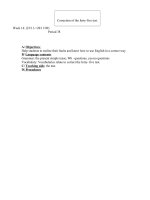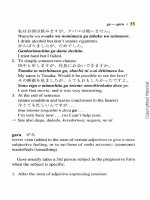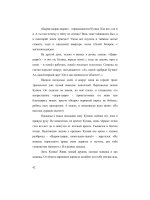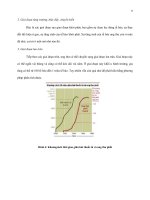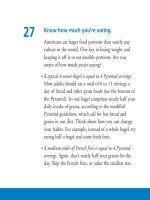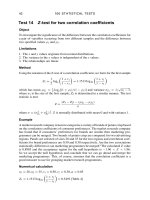gre math review phần 3 pptx
Bạn đang xem bản rút gọn của tài liệu. Xem và tải ngay bản đầy đủ của tài liệu tại đây (198.41 KB, 11 trang )
For example,
348
34484 4
312
3
3
12
3
4
x
x
x
x
x
-=
-+=+
=
=
=
added to both sides
both sides divided by 3
05
0
5
(b) Two variables.
To solve linear equations in two variables, it is necessary to have two
equations that are not equivalent. To solve such a “system” of simultaneous
equations, e.g.,
4313
22
x
y
xy
+=
+=
there are two basic methods. In the first method, you use either equation to
express one variable in terms of the other. In the system above, you could express
x in the second equation in terms of y (i.e.,
x
y
=-22), and then substitute
22-
y
for x in the first equation to find the solution for y:
42 2 3 13
88 3 13
83 5 8
55
1
-+=
-+=
-+ =
-=
=- -
y
y
yy
yy
y
y
0
5
05
0
5
0
5
subtracted from both sides
terms combined
both sides divided by 5
Then
-1 can be substituted for y in the second equation to solve for x:
x
y
x
x
x
+=
+-
()
=
-=
=
()
22
21 2
22
4 2 added to both sides
In the second method, the object is to make the coefficients of one variable
the same in both equations so that one variable can be eliminated by either
adding both equations together or subtracting one from the other. In the same
example, both sides of the second equation could be multiplied by 4, yielding
42 42
x
y
+=
()
05
, or 488
x
y
+=. Now we have two equations with the same
x coefficient:
4313
488
x
y
xy
+=
+=
If the second equation is subtracted from the first, the result is -=55
y
.
Thus,
y
=-1, and substituting -1 for y in either one of the original equations
yields
x
= 4.
22
For more material and information, please visit Tai Lieu Du Hoc at www.tailieuduhoc.org
2.5 Solving Quadratic Equations in One Variable
A quadratic equation is any equation that can be expressed as
ax bx c
2
0++=, where a, b, and c are real numbers a
()
0 . Such an
equation can always be solved by the formula:
x
bb ac
a
=
- -
2
4
2
.
For example, in the quadratic equation
260
2
xx =, a = 2 ,
b
=
-
1, and c
=
-
6. Therefore, the formula yields
x =
()
-
()
-
()
-
()
()
=
=
11426
22
149
4
17
4
2
So, the solutions are
x =
+
=
17
4
2 and x =
-
=-
17
4
3
2
. Quadratic equations
can have at most two real solutions, as in the example above. However, some
quadratics have only one real solution (e.g.,
xx
2
440++=; solution:
x
=-2),
and some have no real solutions (e.g.,
xx
2
50++=).
Some quadratics can be solved more quickly by factoring. In the original
example,
262320
2
xx x x = +
()
-
()
= .
Since
23 20
x
x
+
()
-
()
= , either 230
x
+= or
x
-
=
20 must be true.
Therefore,
230 20
23 2
3
2
x
x
xx
x
+= -=
=- =
=-
OR
Other examples of factorable quadratic equations are:
(a)
xx
xx
2
8150
350
++=
+
()
+
()
=
Therefore, + 3
or
x
x
xx
==-
+= =-
03
50 5
;
;
(b)
490
23230
2
x
xx
-=
+
()
-
()
=
23
For more material and information, please visit Tai Lieu Du Hoc at www.tailieuduhoc.org
Therefore, + 3
or
20
3
2
230
3
2
xx
xx
==-
-= =
;
;
2.6 Inequalities
Any mathematical statement that uses one of the following symbols is called
an inequality.
“not equal to”
<
“less than”
“less than or equal to”
>
“greater than”
“greater than or equal to”
For example, the inequality
417
x
-
states that “41
x
- is less than or equal
to 7.” To solve an inequality means to find the values of the variable that make
the inequality true. The approach used to solve an inequality is similar to that
used to solve an equation. That is, by using basic operations, you try to isolate the
variable on one side of the inequality. The basic rules for solving inequalities are
similar to the rules for solving equations, namely:
(i) When the same constant is added to (or subtracted from) both sides of
an inequality, the direction of inequality is preserved, and the new
inequality is equivalent to the original.
(ii) When both sides of the inequality are multiplied (or divided) by the
same constant, the direction of inequality is preserved if the constant
is positive, but reversed if the constant is negative. In either case the
new inequality is equivalent to the original.
For example, to solve the inequality
-+
3
517
x
,
-+
-
-
-
-
-
-
3517
312 5
3
3
12
3
3
4
x
x
x
x
subtracted from both sides
both sides divided by which
reverses the direction of the inequality)
0
5
(,
Therefore, the solutions to
-+3517
x
are all real numbers greater than
or equal to
- 4. Another example follows:
49
11
5
4 9 55 11
4469
46
4
4
11
1
2
x
x
x
x
x
+
>
+>
>
>
>
both sides multiplied by
subtracted from both sides
both sides divided by
05
0
5
0
5
24
For more material and information, please visit Tai Lieu Du Hoc at www.tailieuduhoc.org
2.7 Applications
Since algebraic techniques allow for the creation and solution of equations
and inequalities, algebra has many real-world applications. Below are a few
examples. Additional examples are included in the exercises at the end of this
section.
Example 1. Ellen has received the following scores on 3 exams: 82, 74, and 90.
What score will Ellen need to attain on the next exam so that the
average (arithmetic mean) for the 4 exams will be 85 ?
Solution: If x represents the score on the next exam, then the arithmetic
mean of 85 will be equal to
82 74
90
4
+++
x
.
So,
246
4
85
246 340
94
+
=
+=
=
x
x
x
Therefore, Ellen would need to attain a score of 94 on the next exam.
Example 2. A mixture of 12 ounces of vinegar and oil is 40 percent vinegar
(by weight). How many ounces of oil must be added to the mixture
to produce a new mixture that is only 25 percent vinegar?
Solution: Let x represent the number of ounces of oil to be added. There-
fore, the total number of ounces of vinegar in the new mixture
will be (0.40)(12), and the total number of ounces of new
mixture will be
12 +
x
. Since the new mixture must be
25 percent vinegar,
012
12
025
.40
.
()()
+
=
x
.
Therefore,
012 12 025
48 3 025
18 025
72
.40 .
.
()()
=+
()()
=+
=
=
x
x
x
x
Thus, 7.2 ounces of oil must be added to reduce the percent of
vinegar in the mixture from 40 percent to 25 percent.
Example 3. In a driving competition, Jeff and Dennis drove the same course
at average speeds of 51 miles per hour and 54 miles per hour,
respectively. If it took Jeff 40 minutes to drive the course, how long
did it take Dennis?
25
For more material and information, please visit Tai Lieu Du Hoc at www.tailieuduhoc.org
Solution: Let x equal the time, in minutes, that it took Dennis to drive the
course. Since distance (d ) equals rate (r) multiplied by time (t),
i.e.,
d
r
t
=
()()
,
the distance traveled by Jeff can be represented by (51)
40
60
,
and the distance traveled by Dennis, (54)
x
60
. Since the
distances are equal,
51
40
60
54
60
34 0 9
37 8
()
=
()
=
x
x
x
.
.
Thus, it took Dennis approximately 37.8 minutes to drive the
course. Note: since rates are given in miles per hour, it was
necessary to express time in hours (i.e., 40 minutes equals
40
60
, or
2
3
, of an hour.)
Example 4. If it takes 3 hours for machine A to produce N identical computer
parts, and it takes machine B only 2 hours to do the same job,
how long would it take to do the job if both machines worked
simultaneously?
Solution: Since machine A takes 3 hours to do the job, machine A can do
1
3
of the job in 1 hour. Similarly, machine B can do
1
2
of the job
in 1 hour. And if we let x represent the number of hours it would
take for the machines working simultaneously to do the job, the
two machines would do
1
x
of the job in 1 hour. Therefore,
1
3
1
2
1
2
6
3
6
1
5
6
1
6
5
+=
+=
=
=
x
x
x
x
Thus, working together, the machines take only
6
5
hours, or
1 hour and 12 minutes, to produce the N computer parts.
26
then
For more material and information, please visit Tai Lieu Du Hoc at www.tailieuduhoc.org
Example 5. At a fruit stand, apples can be purchased for $0.15 each and pears
for $0.20 each. At these rates, a bag of apples and pears was pur-
chased for $3.80. If the bag contained exactly 21 pieces of fruit,
how many were pears?
Solution: If a represents the number of apples purchased and p represents
the number of pears purchased, two equations can be written as
follows:
015 020 380
21
.ap
ap
+=
+=
From the second equation,
ap=-21 . Substituting 21 - p into
the first equation for a gives
015 21 020 380
015 21 015 020 380
315 015 020 380
005 065
13
. .
-+ =
()()
-+ =
-+ =
=
=
pp
pp
pp
p
p
0
5
0
5
pears
Example 6. It costs a manufacturer $30 each to produce a particular radio
model, and it is assumed that if 500 radios are produced, all will be
sold. What must be the selling price per radio to ensure that the
profit (revenue from sales minus total cost to produce) on the
500 radios is greater than $8,200 ?
Solution: If y represents the selling price per radio, then the profit must be
500 30
y
-
05
. Therefore,
500 30 8 200
500 15 000 8 200
500 23 200
46
y
y
y
y
->
->
>
>
05
,
,,
,
.40
Thus, the selling price must be greater than $46.40 to make the
profit greater than $8,200.
27
For more material and information, please visit Tai Lieu Du Hoc at www.tailieuduhoc.org
2.8 Coordinate Geometry
Two real number lines (as described in Section 1.5) intersecting at right
angles at the zero point on each number line define a rectangular coordinate
system, often called the xy-coordinate system or xy-plane. The horizontal
number line is called the x-axis, and the vertical number line is called the y-axis.
The lines divide the plane into four regions called quadrants (I, II, III, and IV)
as shown below.
Each point in the system can be identified by an ordered pair of real numbers,
(x, y), called coordinates. The x-coordinate expresses distance to the left (if
negative) or right (if positive) of the y-axis, and the y-coordinate expresses
distance below (if negative) or above (if positive) the x-axis. For example, since
point P, shown above, is 4 units to the right of the y-axis and 1.5 units above the
x-axis, it is identified by the ordered pair (4, 1.5). The origin O has coordinates
(0, 0). Unless otherwise noted, the units used on the x-axis and the y-axis are the
same.
28
For more material and information, please visit Tai Lieu Du Hoc at www.tailieuduhoc.org
To find the distance between two points, say P(4, 1.5) and
Q(, ), 23 repre-
sented by the length of line segment PQ in the figure below, first construct a
right triangle (see dotted lines) and then note that the two shorter sides of the
triangle have lengths 6 and 4.5.
Since the distance between P and Q is the length of the hypotenuse, we can
apply the Pythagorean Theorem, as follows:
PQ =+ = =() (.) . .645 562575
22
(For a discussion of right triangles and the Pythagorean Theorem, see Section 3.3.)
A straight line in a coordinate system is a graph of a linear equation of the
form
y
mx b=+, where m is called the slope of the line and b is called the
y-intercept. The slope of a line passing through points
P
x
y
11
,
05
and Q
x
y
22
,
05
is defined as
slope
=
-
-
y
y
xx
xx
12
12
12
05
.
For example, in the coordinate system shown above, the slope of the line passing
through points P(4, 1.5) and
Q(, ) 23 is
slope
=
==
15 3
42
45
6
075
.()
()
.
.
.
The y-intercept is the y-coordinate of the point at which the graph intersects the
y-axis. The y-intercept of line PQ in the example above appears to be about
-15., since line PQ intersects the y-axis close to the point (, .).015- This can be
29
For more material and information, please visit Tai Lieu Du Hoc at www.tailieuduhoc.org
confirmed by using the equation of the line,
y
x
b=+075., by substituting the
coordinates of point Q (or any point that is known to be on the line) into the
equation, and by solving for the y-intercept, b, as follows:
y
x
b
b
b
b
=+
-= - +
=- +
=-
075
30752
30752
15
.
(. )( )
(. )()
.
The x-intercept of the line is the x-coordinate of the point at which the graph
intersects the x-axis. One can see from the graph that the x-intercept of line PQ
is 2 since PQ passes through the point (2, 0). Also, one can see that the
coordinates (2, 0) satisfy the equation of line PQ, which is
y
x
=-075 15
30
For more material and information, please visit Tai Lieu Du Hoc at www.tailieuduhoc.org
ALGEBRA EXERCISES
(Answers on pages 34 and 35)
1. Find an algebraic expression to represent each of the following.
(a) The square of y is subtracted from 5, and the result is multiplied by 37.
(b) Three times x is squared, and the result is divided by 7.
(c) The product of
x
+
()
4 and y is added to 18.
2. Simplify each of the following algebraic expressions by doing the indicated
operations, factoring, or combining terms with the same variable part.
(a)
36 11 5
22
xxxx-++ - +
(b)
35 1 4
x
x
-
()
-+
(c)
x
x
x
2
925
4
4
+-
-
()
38
(d)
2531
x
x
+
()
-
()
3. What is the value of the function defined by
fx x x
()
=-+3723
2
when
x
=-2?
4. If the function g is defined for all nonzero numbers y by
gy
y
y
05
=
, what
is the value of
gg2200
()
()
?
5. Use the rules of exponents to simplify the following.
(a)
nn
53
383 8
(e) w
5
3
38
(b)
st
77
3838
(f)
5
03
3838
d
(c)
r
r
12
4
(g)
xy
xy
10 1
55
3838
3838
(d)
2
5
a
b
(h)
31
25
x
yy
6. Solve each of the following equations for x.
(a)
5728
x
-=
(b)
12 5 30-=+
x
x
(c)
5213
x
x
+
()
=-
(d)
x
x
+
()
-
()
=62 1 0
(e)
xx
2
5140+-=
(f)
31080
2
xx+-=
31
For more material and information, please visit Tai Lieu Du Hoc at www.tailieuduhoc.org
7. Solve each of the following systems of equations for x and y.
(a)
x
y
xy
+=
-=
24
18
(b)
320
230
x
y
xy
-=
+=
(c)
15 18 2 3
10 7 20 4 2
x
y
x
y
xy x
=-+
++= +
8. Solve each of the following inequalities for x.
(a)
->+37
x
x
(b)
25 16 10
x
x
+-
(c)
16 8 12+> -
x
x
9. Solve for x and y.
x
y
xy
=
<+
2
57
10. For a given two-digit positive integer, the tens digit is 5 greater than
the units digit. The sum of the digits is 11. Find the integer.
11. If the ratio of 2x to 5y is 3 to 4, what is the ratio of x to y ?
12. Kathleen’s weekly salary was increased 8 percent to $237.60. What was
her weekly salary before the increase?
13. A theater sells children’s tickets for half the adult ticket price. If 5 adult
tickets and 8 children’s tickets cost a total of $27, what is the cost of
an adult ticket?
14. Pat invested a total of $3,000. Part of the money yields 10 percent interest
per year, and the rest yields 8 percent interest per year. If the total yearly
interest from this investment is $256, how much did Pat invest at 10 percent
and how much at 8 percent?
15. Two cars started from the same point and traveled on a straight course in
opposite directions for exactly 2 hours, at which time they were 208 miles
apart. If one car traveled, on average, 8 miles per hour faster than the other
car, what was the average speed for each car for the 2-hour trip?
16. A group can charter a particular aircraft at a fixed total cost. If 36 people
charter the aircraft rather than 40 people, then the cost per person is greater by
$12. What is the cost per person if 40 people charter the aircraft?
32
For more material and information, please visit Tai Lieu Du Hoc at www.tailieuduhoc.org

